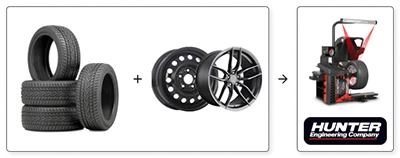The Importance of Wheel Alignment for the Longevity of Your Tires

Wheel alignment is often overlooked by many drivers until they face major driving problems or premature tire wear. Proper alignment is not only crucial for safety but also for the durability of your tires and the overall performance of your vehicle. In this article, we will explore why correct alignment is essential and how it can extend the life of your tires, improve your car's handling, and save you money in the long run.
What is Wheel Alignment?
Wheel alignment, often called wheel geometry, is the process of adjusting the angles of your vehicle's wheels so they are perpendicular to the road and parallel to each other. This adjustment is crucial to ensure that the tires roll correctly on the road. The main angles adjusted during alignment are toe, camber, and caster.
- Toe: This is the angle of the tires pointing inward or outward when viewed from the front of the vehicle. Incorrect toe can cause uneven and rapid tire wear.
- Camber: This is the tilt of the wheels inward or outward. Improper camber can also lead to tire wear on the edges.
- Caster: This is the angle of the steering pivot. It affects the stability and handling of the vehicle.
How Does Poor Alignment Affect Your Tires?
Incorrect alignment can lead to several types of tire wear, such as:
- Wear on one side: This occurs when the camber or toe is poorly adjusted. If one side of the tires wears out faster than the other, it is likely due to misalignment.
- Scalloped or feathered wear: This is characterized by rough surfaces or zigzag patterns on the tires, often due to caster problems or tire imbalance.
- Central or shoulder wear: Excessive wear in the center of the tire can be caused by overinflation, while wear on the shoulders often indicates underinflation or toe issues.
Benefits of Good Alignment
- Extended Tire Life: Proper alignment ensures that tires are used evenly, which increases their lifespan.
- Improved Performance and Safety: Proper alignment enhances vehicle handling, increasing safety while driving.
- Fuel Savings: Well-aligned tires reduce rolling resistance, which can improve your vehicle's fuel efficiency.
Impact of Alignment on Tire Warranties
A point often unknown by motorists is the impact of wheel alignment on the warranties offered by tire manufacturers. Indeed, uneven tire wear, often the result of poor wheel geometry, can lead to the invalidation of the "road hazard" or even the mileage warranty. Tire manufacturers require that tires be used under optimal conditions to ensure their longevity and performance. Thus, when tires exhibit abnormal wear due to an alignment defect, warranties may not be honored. It is therefore crucial to ensure that your vehicle's wheel alignment is regularly checked and adjusted not only to ensure safety and driving efficiency but also to protect your tire investment.
When to Check Wheel Alignment?
It is recommended to have your wheel alignment checked at least once a year or whenever you buy new tires. Additionally, if you notice unusual tire wear or if your vehicle pulls to one side, it is time to consult a specialist.
Conclusion
Good wheel alignment is essential for the health of your tires and for an optimal driving experience. By keeping your tires well aligned, you not only ensure a safer and more pleasant drive, but you also save on long-term costs by avoiding premature wear.
Dominic Vaillancourt
Expert automobile & Porte-parole


